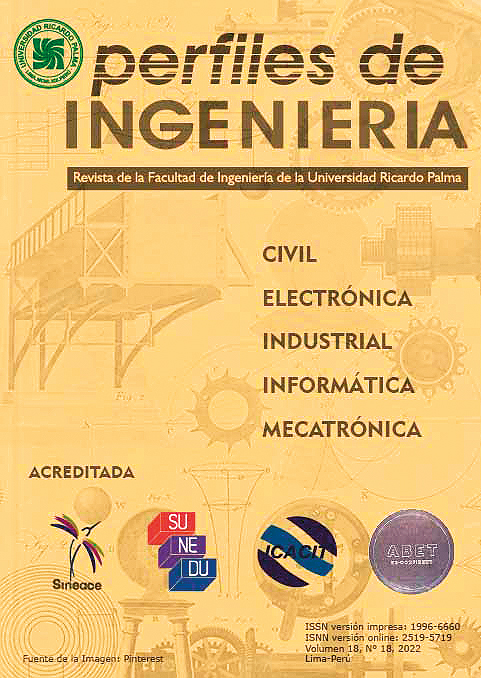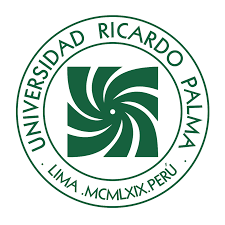Study of a classroom in Universidad Ricardo Palma to avoid Sars-Cov-2 spread
DOI:
https://doi.org/10.31381/perfilesingenieria.v18i18.5402Keywords:
air quality, mechanical ventilation,, carbon dioxide, dispersion of the SARS-Cov-2 virusAbstract
After more than 2 year’s presence of the SARS-CoV-2 virus (COVID-19) among our citizens, sanitary measures have started mitigating its consequences. The Peruvian authorities have considered that as of the month of March 2022 teaching must return to classrooms, both at schools and universities. To do so, we must respect the biosafety protocols established, such as: capacity of students per classroom, adequate distance, use of masks and, above all, good ventilation in classrooms. A poorly ventilated room presents high concentrations of CO2 and reduced levels of oxygen available to breathe, while simultaneously increasing the risk of transmission for respiratory viruses such as SARS-CoV-2. We propose analyzing a model classroom in one of the buildings of the College of Engineering from Ricardo Palma University for its compliance of biosecurity and maximum capacity rules needed to go back to in-person classes. We have chosen classroom B-303 because of its location relative to all other classrooms and because it complies with Peru’s RNE regulations as long as doors and windows are kept open to allow for proper ventilation. We propose to set up this room with the necessary equipment to maintain proper oxygen levels as well as monitor air quality with doors closed. The proposed equipment is made up of air extractors, temperature sensors, and relative humidity and carbon dioxide sensors with a traffic lights monitoring system that indicates the level of carbon dioxide to maintain adequate ventilation of the environment. The limit parameters defined for carbon dioxide (CO2) to determine the quality of the air in a classroom will be: 500-799 ppm Acceptable Value (green color); 800-999 ppm Dangerous Value (amber color) and 1000 ppm Highly Dangerous Value (red color). This proposal can be replicated in any other classroom.
Downloads
References
Plataforma digital única del Estado Peruano. Coronavirus: variantes de la COVID-19 detectadas en el Perú.
https://www.gob.pe/12548-coronavirus-variantes-de-la-covid-19-detectadas-en-el-peru
Organización Mundial de la Salud, Fondo de las Naciones Unidas para la Infancia (UNICEF) y Organización de las Naciones Unidas para la Educación, la Ciencia y la Cultura. (2020) Consideraciones para las medidas de salud pública relacionadas con la escuela en el contexto de la COVID-19: anexo a las consideraciones para ajustar las medidas sociales y de salud pública en el contexto de la COVID-19, 14 de septiembre de 2020. Organización Mundial de la Salud. Fecha de acceso 15-02-2022
Disponible en:
https://apps.who.int/iris/handle/10665/334294 . Licencia: CC BY-NC-SA 3.0 IGO
MINEDU (2022). Modificación de norma de retorno a la presencialidad Año Escolar 2022. RM 048-2022-MINEDU.
INSTITUTO NACIONAL DE SALUD. INS (2021). Efecto de las estrategias de reapertura de escuelas en la transmisión de SARS-CoV-2 en niños y adolescentes. Serie Revisiones Rápidas N°06-2021 INS. Lima, Perú. (agosto 2021).
Reglamento Nacional de Edificaciones–RNE. VIVIENDA (2021). Condiciones Generales de Diseño. Capitulo X Requisitos de Ventilación y Acondicionamiento Ambiental.
Allen J., Spengler J., Jones E., Cedeno-Laurent J. (2020) Guía en 5 pasos para medir la tasa de renovación de aire en aulas. Harvard Healthy Buildings program www.ForHealth.org. Fecha de acceso: 15-02-2022
Disponible en:
IDAEA-CSIC (2020) Guía para ventilación en aulas. Instituto de Diagnóstico Ambiental y Estudios del Agua, Mesura. España. Fecha de acceso 15-02-2022
Disponible en:
https://www.csic.es/sites/default/files/guia_para_ventilacion_en_aulas_csic-mesura.pdf
Reglamento Nacional de Edificaciones-RNE. VIVIENDA (2020). Educación, Numeral III.1 Arquitectura, del Título III Edificaciones, D.S. N° 011-2006-VIVIENDA Resolución Ministerial n° 068-2020-Vivienda. (Modificatoria marzo del 2020).
MINEDU (2021) RM N° 121-2021-MINEDU.pdf pp. 41-43 Revisado: 30-1-2022.
Disponible en: https://cdn.www.gob.pe › uploads › document › file
Downloads
Published
How to Cite
Issue
Section
License
Copyright (c) 2022 Perfiles de Ingeniería

This work is licensed under a Creative Commons Attribution 4.0 International License.
In the event that the manuscript is approved for its next publication, the authors retain the copyright and assign to the journal the right of publication, edition, reproduction, distribution, exhibition and communication in the country of origin, as well as in the abroad, through print and electronic media in different databases. Therefore, it is established that after the publication of the articles, the authors may make other types of independent or additional agreements for the non-exclusive dissemination of the version of the article published in this journal (publication in books or institutional repositories), provided that it is explicitly indicated that the work has been published for the first time in this journal.
To record this procedure, the author must complete the following forms:

1.png)








